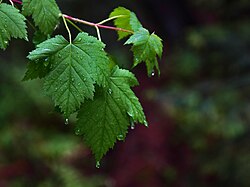Interception (water)

Interception

Intercepted
Mitscherlich in 1971 calculated the water storage potential as interception values for different species and stand densities. A storm event might produce 50 – 100 mm of rainfall and 4 mm might be the maximum intercepted in this way. Grah and Wilson in 1944 did sprinkling experiments where they watered plants to see how much of the intercepted is kept after watering stops.
Trees like Norway maple and a small-leaved lime have an interception of approximately 38% of the gross precipitation in temperate climate.[4]
The interception depends on the leaf area index and what kind of leaves they are.
Interception may increase erosion or reduce it depending on the throughfall effects.
See also
References
- ^ Gerrits, A.M.J. and Savenije, H.H.G. (2011), Interception. In: Peter Wilderer (ed.) Treatise on Water Science Archived 2012-10-12 at the Wayback Machine, vol. 2, pp. 89–101 Oxford: Academic Press.
- ^ Gerrits, A.M.J. and Savenije, H.H.G. (2011) (invited), Forest floor interception. In Levia, D.F., Carlyle-Moses, D.E. and Tanaka, T. (Eds.), Forest Hydrology and Biogeochemistry: Synthesis of Past Research and Future Directions. Ecological Studies Series, No. 216, Springer-Verlag, Heidelberg, Germany
- ISSN 1944-7973.
- ^ Smets, Vincent (2019). "The importance of city trees for reducing net rainfall: comparing measurements and simulations". Hydrology and Earth System Sciences. 23 (9).
External links
- The Experimental Hydrology Wiki Forest Floor Interception
- Gerrits (2010) The role of interception in the hydrological cycle PhD thesis, Delft University of Technology, The Netherlands
